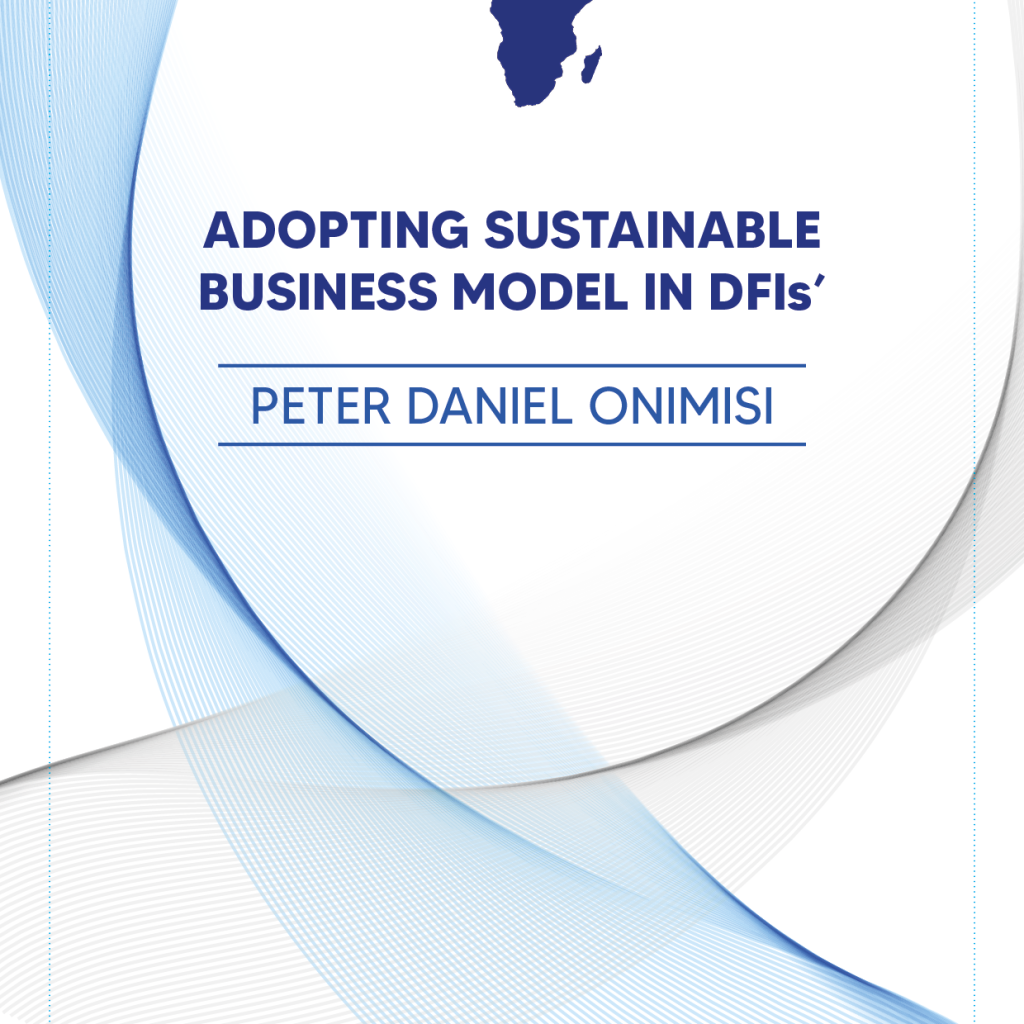
PETER DANIEL ONIMISI (Ph.D.)
Introduction
The last ten years have seen a gradual growth in interest in alternative business models that balance environmental, financial, and social outcomes in light of the ongoing global concerns of environmental degradation, inequality, poverty, and social injustice. The Equator Principles (EP), formulated in June 2003, laid a robust premise for the adoption of ESG in financial institutions. “The Equator Principles (EP) refers to a set of voluntary guidelines adopted by financial institutions to ensure that large-scale development or construction projects appropriately consider the associated potential impacts on the natural environment and the affected communities”[i]. The EP has been revised over the years, with the latest version, EP4, launched in 2019. This suggests that DFIs have a role to play in advancing sustainable practices in economic development.
Contemporary shareholders and investors want to see firms striving to better the world as they create profits. According to Nelson report[ii], 66% of customers would pay more for a product produced by institutions that prioritise sustainability, and 81% of consumers worldwide believe that businesses should do more to protect the environment. Also, employees’ demand for sustainable businesses is rising; when employees feel that they are making a difference, their productivity, job happiness, and loyalty will rise. As a result, it is paramount for financial institutions to create ESG business models to guide their approaches to business as well as a strategy for tracking their business interventions[iii].
Sustainable business models distinguish themselves from the concept of a business model, which only considers the cost structure and the revenue stream in its financial projections, by incorporating the interests of the involved parties, including those relating to the environment and society[iv]. When using sustainable business models, it is possible to take a comprehensive approach to how business is done, considering shareholder interests as well as social and environmental sustainability measures. It’s a business that conducts its operations in a way that either has no negative effects on the community, environment, or society as a whole or that helps to restore earlier, better conditions. The cyclical borrow-use-return model is one idea of a sustainable business model; it clarifies that a truly sustainable business model is one that provides as much as it receives. A sustainable business “borrows” resources with the intention of replenishing them rather than taking them directly from the earth.
A well-drafted ESG strategy that satisfies contractual obligations while mainstreaming the DFIs approach to governance, stakeholder wellbeing, and climate change can serve as a competitive advantage and contractual requirement as donors and corporate financiers are now mainstreaming ESG[v]. A robust ESG strategy also provides cost savings through improved process efficiencies to counter rising operating expenses and helps organizations cope with regulatory pressure. According to a McKinsey study[vi], a company’s financial performance and resource efficiency are significantly correlated. It was also discovered that lowering resource costs can boost operating profits by as much as 60%. An effective ESG strategy can help a DFI create a solid foundation for establishing compliance policies and procedures that satisfy statutory and necessary reporting requirements.
Some Example of ESG in Businesses;
By 2040, Apple, Port of Tyne, and Unilever promises that both their products and supply chain will be completely carbon neutral[vii].
By converting to all-electric machinery driven by ecologically acceptable resources, Nissan Motor hopes to eliminate carbon dioxide emissions from all manufacturing facilities worldwide by 2050[viii]. FedEx reduced its fleet’s fuel consumption by more than 50 million gallons by switching 20% of its 35,000 vehicles to electric or hybrid engines[ix].
The Development Bank of Southern Africa (DBSA) through its Embedded Generation Investment Programs supported Independent power producers in South Africa who are developing and expanding integrated generation projects utilizing solar photovoltaic and wind energy. Once all projects are completed, the investment is expected to add 330 MW of solar photovoltaic and wind generating capacity, directly avoiding more than 700,000 tCO2e of emissions each year[x].
The Waste-to-Energy Project in Azerbaijan financed by the Islamic Development Bank (IsDB) utilises 500,000 tons of municipal solid waste to produce 230 GWh of electricity annually, enough to power 50,000 households[xi].
How to Build a Sustainable Business Model
In order to establish a sustainable business model, it is recommended to undertake the following measures, while ensuring the involvement of both the team and stakeholders.
The initial step involves the deconstruction of the products and services offered. This step entails analysis of banks’ products and services in order to identify potential areas for enhancement with regards to sustainability. While attaining a completely sustainable solution may not be feasible, implementing changes that result in substantial improvement can still be a worthwhile endeavor. In the pursuit of enhanced sustainability, it is imperative to conduct thorough testing and effectively communicate any modifications to the intended customer base. It is imperative to re-evaluate the cost and pricing models to safeguard profitability.
The second step involves conducting a thorough examination of banks’ organizational procedures. After optimizing products or services for sustainability, the next task involves devising business processes that facilitate their sustainable creation and distribution to customers. Illustrate your organizational procedures and chart the sequence of events and corresponding inputs. Identify the inputs and waste-generating factors that pose the most significant challenges or are unsustainable, and prioritize addressing them as they are likely to yield the highest benefits. In addition, it is advisable to remain vigilant for expeditious accomplishments, such as the possibility of diminishing mileage, decreasing water usage, transitioning to an environmentally-friendly energy plan, and other similar measures. Conduct an analysis of your supply chain. To what extent do their business practices exhibit sustainability? Initiate the prioritization process by starting with the suppliers from whom you procure the highest quantity and value of goods, and subsequently proceed to evaluate the remaining suppliers in a descending order based on their relative influence. Collaborate with your primary suppliers or explore potential new ones to aid in the advancement of your sustainable business model innovation.
The third step involves a targeted approach towards individuals in order to discern the necessary people skills, resources, roles, training, and culture required to effectively implement a sustainable business model innovation. This implementation should eventually become a standard practice within the organization. The successful implementation of change requires individuals possessing appropriate competencies and drive, as well as the establishment of novel operational methodologies. It is imperative to provide training to individuals for proficiently executing novel operational procedures, optimizing their competencies, and fostering their self-assurance and involvement in the fresh business paradigm.
The fourth step involves utilizing data to facilitate ongoing improvement. It is recommended to establish Key Performance Indicators (KPIs) at the outset of a sustainable business model project, and subsequently employ data to monitor and evaluate progress.
Sustainable Business Model Archetypes[xii]
These refers groupings of approaches and solutions designed to improve sustainability.
Environment-centered archetypes include:
- Lower content for products and packaging
- LEAN manufacturing principles
- Low-carbon manufacturing
- Increased functionality of products
- Moving from non-renewable to renewable energy sources
- Local energy solutions.
- The Three Layer Business Model Canvas (TLBMC).
Socially responsible archetype examples are:
- Consumer education
- Demand management
- Product durability and longevity.
- Responsible product distribution/ promotion
- Cambridge Value Mapping Tool
Conclusion
Financial institutions must expand their goals from ones that prioritize profit maximization to include social and environmental considerations. A commitment to sustainability would require financial institutions to fully integrate the consideration of ecological limits, social equity, and economic justice into corporate strategies and core business areas (including credit, investing, underwriting, and advising), to put sustainability objectives on an equal footing to maximization of shareholder value and client satisfaction, and to aim to finance transactions that promote sustainability actively.
The implementation of sustainable practices in businesses can vary from minor modifications and replacements, such as the adoption of LED lighting across its operational activities, switching from fossil fuel vehicle vehicles to eco-friendly fuel/ electric cars, to pioneering research and development endeavors aimed at devising innovative solutions, such as BioTech Fashion. BioTech Fashion utilizes a low-energy technology to process textile waste and subsequently convert it into a novel, eco-friendly materials.
DFIs can prioritize several key vital aspects to enhance their sustainability, including information technology, the circular economy, value chains, core values, value creation, organizational values, performance management, and stakeholder engagement[xiii]. For instance, circular business models aim to optimize the utilization of products and materials by prolonging their lifespan and maximizing their value. Incorporating reuse, recycling, repurposing, and sustainable disposal of products, process outputs, and materials utilized in the value chain is regarded as an essential component of the organization’s value chain.
[i] Mizuho 2023. What are the “Equator Principles”? Launch of the “Equator Principles” retrieved from https://www.mizuhogroup.com /sustainability/business-activities/investment/equator/about#:~:text=The%20Equator% 20Principles%20(EP)%20are,environment%20and%20the%20affected%20communities on 27th April 2023.
[ii] Nelson Report 2023. Retrieved from https://ashtonmanufacturing.com.au/66-of-consumers-willing-to-pay-more-for-sustainable-goods-nielsen-report-reveals/ on 27th April 2023.
[iii] Marcos, L. and Patricia, B. 2017. Business Model Canvas Acceptance among French Entrepreneurship Students: Principles for Enhancing Innovation Artefacts in Business Education. Journal of Innovation Economics. 23, pp. 1-25
[iv] Geissdoerfer, M., Vladimirova, D., and Evans, S. 2018. Sustainable Business Model Innovation: A Review. J. Clean. Prod. 2018, 198, 401–416.
[v] Schaltegger, S., Lüdeke-Freund, F., and Hansen, E.G., 2012. Business cases for sustainability: the role of business model innovation for corporate sustainability. International journal of innovation and sustainable development, 6(2), pp.95-119.
[vi] https://www.mckinsey.com/capabilities/strategy-and-corporate-finance/our-insights/five-ways-that-esg-creates-value
[vii] https://www.theguardian.com/technology/2020/jul/21/apple-promises-to-become-fully-carbon-neutral-by-2030
[viii] https://www.nissan-global.com/EN/SUSTAINABILITY/ENVIRONMENT/CARBONNEUTRAL/
[ix] https://newsroom.fedex.com/newsroom/middle-east-indian-subcontinent-and-africa/fedex-deploys-electric-vehicles-to-advance-sustainability-goal-of-zero-emissions-last-mile-delivery-in-india
[x] https://www.dbsa.org/embedded-generation-investment-programme
[xi] https://www.isdb.org/sites/default/files/media/documents/2020-06/Success_Lflt_Azerbaijan_EN.pdf
[xii] https://bigbangpartnership.co.uk/sustainable-business-model-innovation/
[xiii] Konecná, Z., Goni, F., Gholamzadeh, C.A., Mohammadi, Z., Khademizadeh, S., and Klemeš, J. 2021. Review of Research on Sustainable Education Influenced by the COVID-19 Pandemic. Chemical Engineering Transactions. 88. 985-990. 10.3303/CET2188164.
